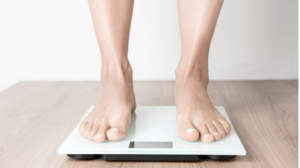Best Way to Weigh Yourself
Getting in the habit of weighing yourself can bring good (and bad) fortune. For some, it’s a simple part of their morning routine that doesn’t require much thought. For others, figuring out the best regime to weigh themself is a task on its own – much less the working out, eating well, and tracking that usually comes with it.
We have come up with an easy checklist that can have your weigh-in routine feel effortless.
Weigh yourself:
- Daily
- In the mornings
- With consistent factors
- With a tracker
- And only if it doesn’t cause anxiety or disordered eating
Now, let’s dive deeper into each of these steps!
Daily Weigh-Ins
Time to get that old-fashioned calendar out (or just your smartphone if you prefer) and set a reminder to weigh in every day!
If you’re tracking progress, whether for muscle gain or weight loss, weighing in daily will give you an accurate picture of your bodily changes day-to-day, as well as the bigger picture after a few weeks. There’s a ton of research on self-monitoring showing how people that weigh in more frequently are more likely to lose or maintain weight. Knowing that your next weigh-in is just a day away instead of a week, gives you more motivation to eat well and get in some exercise NOW rather than pushing it off for a few days.
Remember – consistency is key when it comes to getting in shape and losing weight!
Weigh Yourself in the Mornings
This one just makes sense. Your body is at its most natural weight right after waking up! Rather than hopping on the scale after eating a meal, or drinking a bottle of water, make your daily weigh-in a part of your morning bathroom routine.
Weighing yourself in the morning is most effective because your body has had adequate time to digest and process your food from the day before. A morning weigh-in means the number won’t be affected by what you’ve eaten or haven’t processed yet.
Not a morning person? Don’t worry – this step isn’t telling you that you have to be up and walking around at the crack of dawn every day. Just weigh yourself first thing at your natural wake-up time!
Keep Factors Consistent
What does “keep factors consistent” even mean? Put simply, if you want your weigh-in to be as accurate as possible, you have to try your best at keeping external factors to the minimum. For example, if you weigh yourself naked one day, then layered with clothing the next, the number on the scale is going to be different – but will have nothing to do with whether you’ve gained or lost weight.
Be consistent when you weigh yourself. Try to weigh yourself at the same time, in the same way. If you want your bare weight – weigh yourself right before you step into the shower after you’ve taken your clothes off. If not, weigh yourself before the clothes come off. If you do choose to weigh yourself with clothes on, it’s best to even try to weigh yourself in the same clothes. How about a pyjama weigh-in?
Track Your Progress
Ok, so. You’re weighing yourself daily, at the same time, and keeping your variables consistent. Great! Now if you want to see your progress – you have to track it! Tracking your weight loss – whether on a spreadsheet, notepad or an app on your phone – will help you better understand the overall picture of what’s happening to your body.
And let’s face it – who is going to remember what they weighed in at 5 weeks ago without writing it down somewhere? Unless you have an insane memory – I think most of us are in the same boat.
Keeping track of your weight loss will help you identify patterns, and let you know if you are moving in the right direction at the speed you want. It can also be used as a motivating factor when you feel like ditching the diet and weight loss goals.
Even better – make it automatic! Invest in a smart scale that can keep track of your progress for you. Not only will the scale and app automatically track your weight loss progress, but smart scales also measure things other than weight, like body fat percentage and muscle mass, which can give you a better overview of your health as a whole.
Ditch the Numbers
Feeling overwhelmed? Starting to feel yourself get into unhealthy habits? It’s OK to ditch the scale entirely. Especially if it will make you feel better about yourself.
Does its presence trigger a spiral of negative thoughts and self-talk? Dump it and consider that 2 pounds lost! Sometimes the best measurement is progress, including discovering that the scale isn’t for you. Weigh-ins can be left to meetings with your healthcare provider so you can focus your energy on other things that make you healthy and happy.
Scales that use alternatives to numbers, such as colors, eliminate the scale anxiety that many accumulate when consistently tracking their weight loss journey. Especially when these daily results aren’t what they expect or want.
In conclusion, it’s important to remember that while the scale is a helpful way to gauge your progress, it’s by no means the only way. Part of weighing yourself the right way is recognizing that the number on the scale doesn’t always tell the whole story! There are many other weights to adequately track your weight loss progress such as how you feel, your energy levels, the fit of your clothes, and keeping a mindful eating log.
By learning alternatives to viewing an intimidating number each day, you may ditch the scale quicker than expected.




